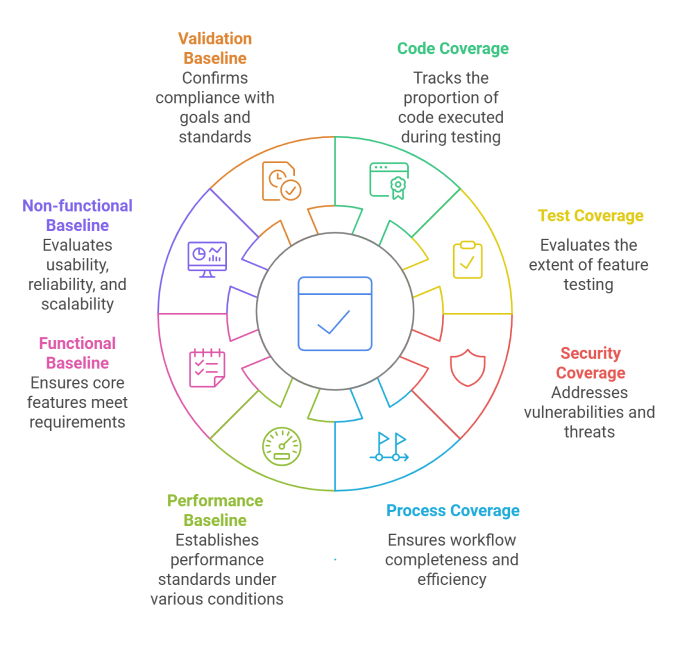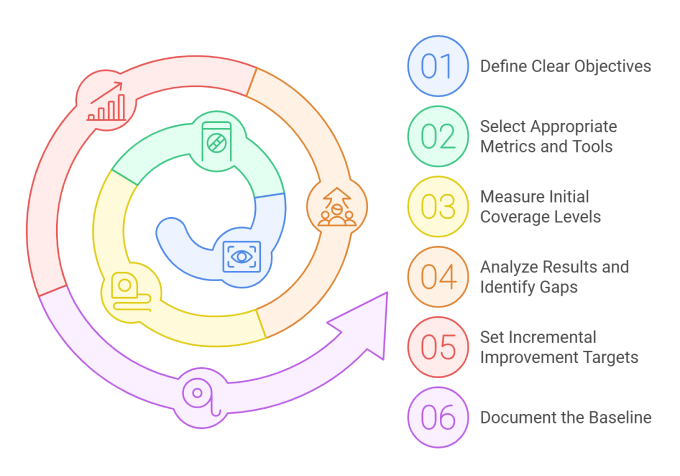Baseline Coverage
What is baseline coverage?
Baseline coverage is a reference point or starting metric used to evaluate the current state of a system, process, or project. It acts as a benchmark for measuring improvements and detecting issues over time. Whether applied to code coverage, test coverage, or security coverage, it provides critical insight into a software system’s health and reliability. By setting clear initial metrics, teams can:
- Gain a comprehensive understanding of the current state of quality.
- Pinpoint areas needing improvement.
- Track progress and make informed decisions based on data.
Why is baseline coverage important?
- Quality assurance: Setting a baseline helps teams verify that essential parts of the system are tested and functioning as intended. It serves as a safety net to catch critical issues early.
- Progress tracking: Enables teams to measure improvements over time by comparing new metrics to the baseline.
- Risk reduction: By highlighting untested or vulnerable areas, baseline assessment reduces the risk of undetected issues.
- Resource optimization: Teams can prioritize testing and development efforts effectively.

Types of baseline coverage
Baseline coverage can be categorized in two primary ways: by specific coverage metrics or by testing objectives. Each perspective serves unique needs and enhances the testing strategy.
By coverage metrics
- Code coverage: Measures the percentage of code executed during testing and identifies untested sections to guide further test creation.
- Test coverage: Evaluates the thoroughness of feature and functionality testing, ensuring alignment with application requirements.
- Security coverage: Tracks how well vulnerabilities and threats are addressed. You can use tests like static code analysis (SAST) and dynamic analysis (DAST).
- Process coverage: Focuses on workflows or business processes to ensure completeness and efficiency.
By testing objectives
- Baseline performance testing: Establishes a baseline for system performance under normal and stressed conditions, revealing bottlenecks and scalability limits.
- Functional baseline testing: Verifies that key system features meet their requirements and confirms the functionality of core components, such as login or payment systems.
- Non-functional baseline testing: Assesses aspects like performance, reliability, and user experience. Ensures the system operates efficiently under different conditions.
- Validation baseline testing: Confirms compliance with project requirements and industry standards. Ensures the system meets legal, safety, or performance criteria.
[blog-subscribe]
Establishing and implementing baseline coverage

Creating baseline coverage is not just a conceptual task but a hands-on process. Here’s a step-by-step guide to help you establish baseline coverage effectively, with relevant examples:
1. Define clear objectives
Start by identifying the goals of your baseline coverage. For instance, you might want to ensure that critical parts of your codebase are tested or reduce the risk of production issues. Align these goals with your project’s overall objectives. For example, in an e-commerce application, a goal might be to ensure all checkout-related functions are tested thoroughly.
2. Select appropriate metrics and tools
Decide what to measure and select tools that can automate the process. For instance:
- Code coverage tools: Tools like JaCoCo or Istanbul help measure how much of your code is executed during testing. They generate detailed reports to guide test planning.
- Test management tools: Tools like TestRail streamline test organization, track execution, and support collaboration for large teams. They simplify managing tests across large teams or projects.
- Security analysis tools: Employ tools like SonarQube to scan for vulnerabilities.
3. Measure initial coverage levels
Run the selected tools to gather baseline data. For instance, using JaCoCo might yield a report showing that 70% of your code is covered by tests. Standardizing how these measurements are taken ensures accuracy and consistency.
4. Analyze results and identify gaps
Review the baseline report to find areas with insufficient coverage. For instance, if the report shows low branch coverage in critical methods, prioritize creating tests for those areas.
5. Set incremental improvement targets
Avoid trying to achieve 100% coverage immediately. Instead, set realistic goals such as increasing branch coverage from 50% to 75% within a sprint.
6. Document the baseline
Record all baseline data and share it with stakeholders. For example, maintain a shared document detailing current coverage metrics, tools used, and identified gaps.
7. Iterate and improve
Continuously refine your coverage by adding tests for new features and revisiting old ones. Use automation pipelines to ensure updates are tracked and evaluated automatically.
Example CI/CD Integration:
steps: - name: Run Tests run: mvn test - name: Generate Coverage Report run: mvn jacoco:report
By following these steps, baseline coverage evolves into a robust system for ensuring consistent quality and identifying areas for improvement.
Challenges in establishing baseline coverage
Despite its benefits, implementing baseline coverage is not without challenges:
- Lack of clear objectives: Teams may struggle to define the purpose of their baseline coverage.
- Complex systems: Measuring coverage in large, interconnected systems can be difficult.
- Resource constraints: Insufficient tools, time, or expertise can hinder implementation.
Conclusion
Baseline coverage is an essential part of maintaining high-quality software. It gives teams a starting point to evaluate their systems, identify weak spots, and track improvements over time. While challenges like complex systems or limited resources may arise, clear goals and consistent updates can ensure success.